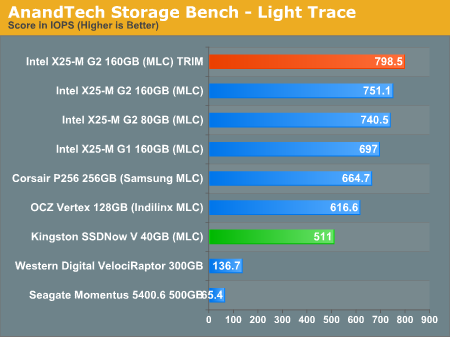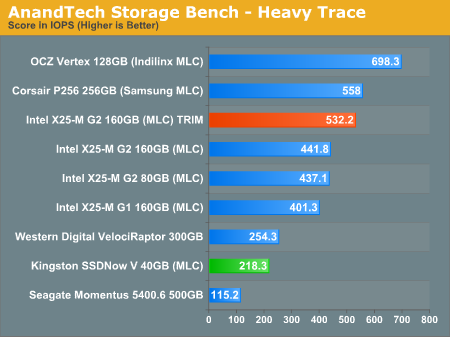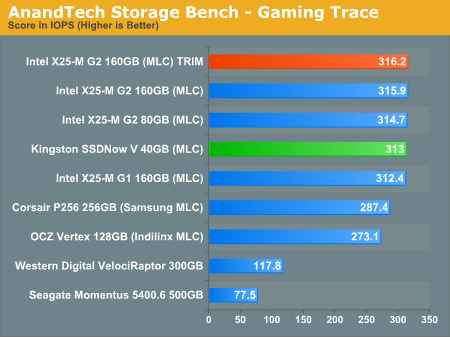The SSD Improv: Intel & Indilinx get TRIM, Kingston Brings Intel Down to $115
by Anand Lal Shimpi on November 17, 2009 7:00 PM EST- Posted in
- Storage
Introducing the AnandTech Storage Bench - Real World Performance Testing
Finding good, real world, storage benchmarks is next to impossible. The synthetic tests work up to a certain point but you need real world examples. Measuring performance in individual applications often ends up with charts like these where all of the drives perform identically. Benchmark suites like PCMark Vantage are the best we can do, but they are a bit too easy on these drives in my opinion and while representative of a real world environment, they aren’t necessarily representative of all real world environments.
Recently we’ve been able to get our hands on a piece of software that allows us to record all disk activity on a machine and then play it back on any other machine. The point is that we can now model a real world usage scenario without waiting for BAPCo or Futuremark to do it for us.
Our benchmarks debut here, today, and we’re starting with three. We haven’t had time to run all of the SSDs through this new suite so we’ll start with an abridged list.
The first in our new benchmark suite is a light usage case. The Windows 7 system is loaded with Firefox, Office 2007 and Adobe Reader among other applications. With Firefox we browse web pages like Facebook, AnandTech, Digg and other sites. Outlook is also running and we use it to check emails, create and send a message with a PDF attachment. Adobe Reader is used to view some PDFs. Excel 2007 is used to create a spreadsheet, graphs and save the document. The same goes for Word 2007. We open and step through a presentation in PowerPoint 2007 received as an email attachment before saving it to the desktop. Finally we watch a bit of a Firefly episode in Windows Media Player 11.
There’s some level of multitasking going on here but it’s not unreasonable by any means. Generally the application tasks proceed linearly, with the exception of things like web browsing which may happen in between one of the other tasks.
The recording is played back on all of our drives here today. Remember that we’re isolating disk performance, all we’re doing is playing back every single disk access that happened in that ~5 minute period of usage. The light trace is composed of 37,501 reads and 20,268 writes. Over 30% of the IOs are 4KB, 11% are 16KB, 22% are 32KB and approximately 13% are 64KB in size. Less than 30% of the operations are absolutely sequential in nature. Average queue depth is 6.09 IOs.
The performance results are reported in I/O Operations per Second (IOPS):

The hard drives set the minimum level of expectations here, the VelociRaptor only manages 137 IOPS. The fastest SSD is the X25-M G2 with the TRIM firmware installed at nearly 800 IOPS. The improvement over the older firmware is 6.25% thanks to the higher sequential write speed. The G2 is a bit faster than the G1 here, but what’s most interesting is how well the competing SSDs do.
Corsair’s P256 based on the Samsung RBX controller is very close to the performance of Intel’s X25-M G1 at 664 IOPS. It even outperforms the Indilinx MLC based OCZ Vertex by around 8%.
The Kingston 40GB drive is hampered by its small amount of free space. The actual benchmark takes up around 33GB of space, leaving very little breathing room for the baby SSD. That being said, the hopefully $85 bugger is nearly 4x the speed of a VelociRaptor.
If there’s a light usage case there’s bound to be a heavy one. In this test we have Microsoft Security Essentials running in the background with real time virus scanning enabled. We also perform a quick scan in the middle of the test. Firefox, Outlook, Excel, Word and Powerpoint are all used the same as they were in the light test. We add Photoshop CS4 to the mix, opening a bunch of 12MP images, editing them, then saving them as highly compressed JPGs for web publishing. Windows 7’s picture viewer is used to view a bunch of pictures on the hard drive. We use 7-zip to create and extract .7z archives. Downloading is also prominently featured in our heavy test; we download large files from the Internet during portions of the benchmark, as well as use uTorrent to grab a couple of torrents. Some of the applications in use are installed during the benchmark, Windows updates are also installed. Towards the end of the test we launch World of Warcraft, play for a few minutes, then delete the folder. This test also takes into account all of the disk accesses that happen while the OS is booting.
The benchmark is 22 minutes long and it consists of 128,895 read operations and 72,411 write operations. Roughly 44% of all IOs were sequential. Approximately 30% of all accesses were 4KB in size, 12% were 16KB in size, 14% were 32KB and 20% were 64KB. Average queue depth was 3.59.

While I appreciate that Intel improved sequential write speed a bit in the 160GB G2 drives, the heavy trace results show us that it’s not enough. The improvement to the 160GB G2 is tremendous, over 20%. But that only brings the 160GB G2 up to the performance of the Corsair P256 (Samsung RBX). The real winner here is the Indilinx based OCZ Vertex. At nearly 700 IOPS it has the right balance of random and sequential read/write speed for our heavy usage scenario. To quote from the Relapse:
“When I started writing this article I took a big step. I felt that Indilinx drives had reached the point that their performance was good enough to be considered an Intel alternative. I backed up my X25-M, pulled it out, and swapped in an OCZ Vertex drive - into my personal work system. I've been using it ever since and I must admit, I am happy. Indilinx has done it, these drives are fast, reliable (provided that you don't upgrade to the latest firmware without waiting a while) and are good enough.”
This is more than good enough, this is faster than Intel.
Unfortunately Intel has assured me that there’s no additional write speed left on the table for the X25-M G2. We’ll have to wait for the G3 next year to see that addressed.
Kingston’s very low sequential write speed hurts it the most here, the drive actually delivers performance lower than that of a VelociRaptor (although not by much). To be honest, this is a bit of an unfair test for the 40GB drive. It’s far too intense for what would ultimately be an apps/OS drive, but it does highlight the 40GB drive's weakpoints.
Our final test focuses on actual gameplay in four 3D games: World of Warcraft, Batman: Arkham Asylum, FarCry 2 and Risen, in that order. The games are launched and played, altogether for a total of just under 30 minutes. The benchmark measures game load time, level load time, disk accesses from save games and normal data streaming during gameplay.
The gaming trace is made up of 75,206 read operations and only 4,592 write operations. Only 20% of the accesses are 4KB in size, nearly 40% are 64KB and 20% are 32KB. A whopping 69% of the IOs are sequential, meaning this is predominantly a sequential read benchmark. The average queue depth is 7.76 IOs.

The gaming test is almost entirely reads and thus the Intel drives have no weaknesses. The G2s, G1s, TRIM or not, all perform about the same here. They’re about 10% faster than Samsung and 15% faster than Indilinx. Even the 40GB Kingston does just as well here.










162 Comments
View All Comments
Pandamonium - Monday, October 26, 2009 - link
The 2nd gen X18-M isn't available as far as I can tell. It kind of shafts us tablet and ultraportable users out of the SSD market for another round =/Cavicchi - Monday, October 26, 2009 - link
"You no longer have to boot to DOS and secure erase your SSD before installing Windows, just quick format the partition before installing Windows 7."I always thought the "quick format" doesn't wipe the entire drive as clean as a full/long format. Does the above mean we only need to do a quick format to wipe a drive clean to install Windows 7?
Also, I noticed Superfetch, Prefetch, and Ready Boost are enabled in Windows 7 x64 with my X25-M G2 160GB drive installed.
Voo - Monday, October 26, 2009 - link
Logically when a TRIM command is sent to the drive you lose all the data that was saved there.So, there's no difference between full/quick format or anything else as long as it triggers the TRIM command..
Beno - Monday, October 26, 2009 - link
"SSDs are made up of millions of NAND flash cells. They can be written to in groups called pages (generally 4KB in size) but can only be erased in larger groups called blocks (generally 128 pages or 512KB). These stipulations are partially the source of many SSD performance issues."but isnt it possible to erase data in 4KB, the same way they are written?
krumme - Monday, October 26, 2009 - link
Where does speed matter most?Getting some sense into the g2 hype
Now you can have a job with a Dell and a hd with samsung controller without quitting the job
Thanx Anand for always improving your site and letting us learn
Thats whats move this boys-toy business forward
flynace - Monday, October 26, 2009 - link
If you set up a software RAID-0 array within Windows 7 will it support TRIM?Or is TRIM not possible on any form of RAID (OS, BIOS, HW, etc.)?
And does aliging the partitions make any difference on these drives?
Voo - Monday, October 26, 2009 - link
Iirc Anand stated in some of his articles that there's no TRIM support for raid, because the controller had to forward the commands.But imho it sounds not like a unconquerable problem, so it's probably only a question of time.
flynace - Tuesday, October 27, 2009 - link
Thanks. I assume Intel will update their drivers to support RAID TRIM eventually, but if you don't have an 'R' tybe Intel ICH, does Win7 support TRIM if you set up a software RAID array in the OS still using the MS AHCI drivers?Willardjuice - Monday, October 26, 2009 - link
Did Intel update their Windows 7 sata/raid drivers to also include TRIM support? Or do we have to use the drivers provided by Microsoft?DoveOfTheSouth - Monday, October 26, 2009 - link
Another great SSD article from Anand (thank you so much)!But I'm really disappointed that you have to use the Microsoft Win 7 disk driver to get TRIM. It has a huge problem.
Based on my experience, I would normally strongly recommend that the first thing you do when installing Win 7 is replace the Microsoft driver with the latest Intel Matrix Storage Manager.
The following link describes the problem (long periods of system non-responsiveness) you can get with the Microsoft driver and at least some PCs, and how to fix it:
http://blogs.zdnet.com/Bott/?p=1431&page=3&...">http://blogs.zdnet.com/Bott/?p=1431&page=3&...
I had exactly the same crippling problem on a Dell Dimension 9100 which baffled me until I replaced the Microsoft driver with IMSM - problem disappeared instantly.
Okay it was bit of an old PC but of the 3 I have been testing with Win 7 for the last couple of months, it was the only one that used the Microsoft driver instead of IMSM (it was an XP upgrade ie OS reinstall, the others upgrades from Vista). So I don't know how widespread the problem with the Microsoft driver is, it hit my only PC that was a candidate, but I'd be pretty wary.
Otherwise Win 7 has been great.
So it looks like you have a choice: IMSM with no TRIM or a buggy Microsoft driver with TRIM.